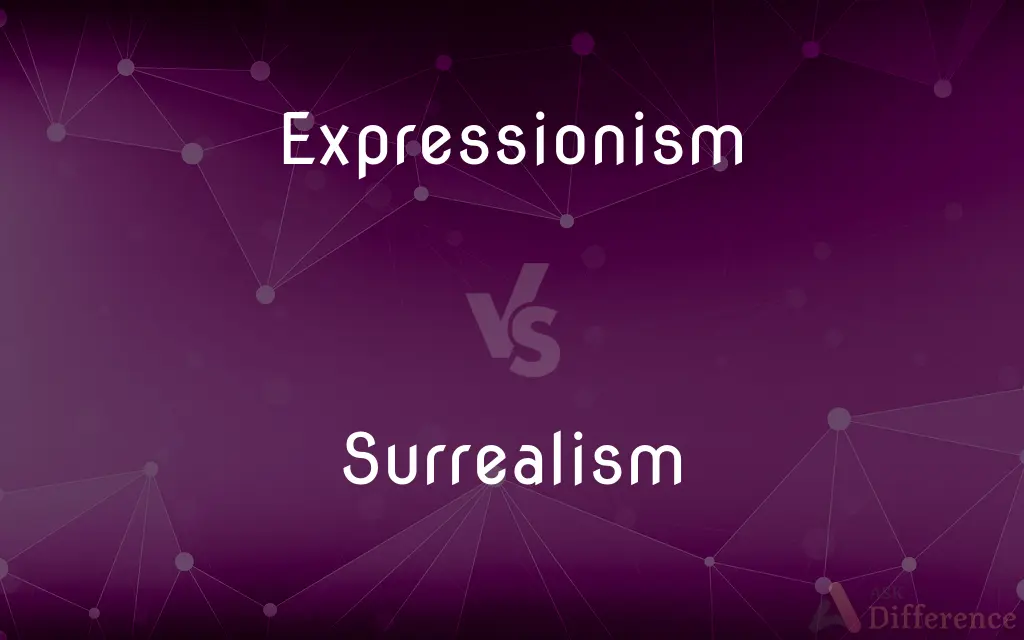Expressionism vs. Surrealism — What's the Difference?
By Tayyaba Rehman — Updated on September 26, 2023
Expressionism emphasizes representing emotional experience over objective reality, focusing on subjective perception. Surrealism seeks to express the subconscious, using dream-like, illogical scenes.

Difference Between Expressionism and Surrealism
Table of Contents
ADVERTISEMENT
Key Differences
Expressionism and Surrealism are distinguished art movements, each contributing distinct philosophies and styles to the art world. Expressionism, emerging in the early 20th century, prioritizes the expression of emotional experience and subjective perception over objective reality. It embraces distortion and exaggeration for emotional effect, intending to evoke moods or ideas and depicting the world from a subjective perspective, highlighting individual and collective anxieties and desires.
Surrealism, on the other hand, originated in the late 1910s and early 1920s as a literary movement before expanding into visual arts. It seeks to release the creative potential of the unconscious mind, often employing dream-like scenes, illogical structures, and bizarre juxtapositions. Surrealism aims to reconcile dream and reality, exploring the irrational dimensions of the mind, and emphasizing the role of chance and spontaneity in artistic creation.
Expressionism is rooted in an intense expression of subjective emotions and responses. Artists employing this style tend to focus on their internal feelings and thoughts rather than replicating the external world, using distorted and exaggerated forms, intense color, and dynamic, agitated compositions to convey inner turmoil or passionate emotions, reflecting a more personal, introspective exploration of human experience.
Conversely, Surrealism delves into the irrational and the subconscious, utilizing bizarre, fantastical imagery and illogical juxtapositions to explore the hidden depths of the mind. The works often feature unexpected, dreamlike sequences and elements of surprise, revealing the uncanny and the inexplicable, driven by a desire to explore the unknown and the mysterious aspects of human consciousness.
In summary, while Expressionism aims to articulate subjective emotions and perceptions through exaggerated and distorted representations, Surrealism delves into the subconscious mind, blending reality and dream to unearth the mysteries of the human psyche.
ADVERTISEMENT
Comparison Chart
Focus
Emotional experience and subjective perception
The subconscious, dream-like, and illogical scenes
Origins
Early 20th Century
Late 1910s and early 1920s
Representation
Distorted and exaggerated for emotional effect
Bizarre juxtapositions and dream-like scenes
Philosophical Aim
Evoke moods or ideas, depict subjective perspective
Reconcile dream and reality, explore the irrational
Methods/Techniques
Intense color, dynamic compositions
Elements of surprise, fantastical imagery
Compare with Definitions
Expressionism
An art movement emphasizing subjective emotion over objective representation.
Expressionism in painting often uses distorted imagery to convey intense emotion.
Surrealism
An artistic movement focused on expressing the subconscious and irrational mind through dream-like scenes.
Surrealism often employs bizarre and illogical structures to explore the mysteries of the mind.
Expressionism
Utilizes exaggerated and intense forms and colors to represent internal feelings and thoughts.
Expressionism is marked by a bold use of color and exaggerated forms to depict subjective emotions.
Surrealism
Seeks to release the creative potential of the unconscious mind by reconciling dream and reality.
Surrealism unveils the uncanny and inexplicable aspects of human consciousness through dream-like imagery.
Expressionism
Focuses on representing emotional experiences rather than depicting objective reality.
The distorted forms in Expressionism seek to evoke the artist’s inner feelings.
Surrealism
Utilizes unexpected elements and juxtapositions to represent the irrational dimensions of the mind.
The fantastical imagery in Surrealism reveals the hidden depths and irrationalities of the subconscious mind.
Expressionism
Expressionism is a modernist movement, initially in poetry and painting, originating in Northern Europe around the beginning of the 20th century. Its typical trait is to present the world solely from a subjective perspective, distorting it radically for emotional effect in order to evoke moods or ideas.
Surrealism
Emphasizes the role of chance and spontaneity in artistic creation to explore the unknown.
Surrealism allows for the exploration of the mysterious aspects of the mind through spontaneous and unexpected juxtapositions.
Expressionism
A movement in the arts during the early 1900s that emphasized distortion of external reality in order to express the artist's subjective experience.
Surrealism
Blends reality and dream to explore and express the mysterious aspects of human psyche.
Through Surrealism, artists seek to unearth the mysteries of the human psyche by blending elements of reality and dream.
Expressionism
A movement in the arts in which the artist did not depict objective reality, but rather a subjective expression of their inner experiences
Surrealism
Surrealism was a cultural movement which developed in Europe in the aftermath of World War I and was largely influenced by Dada. The movement is best known for its visual artworks and writings and the juxtaposition of distant realities to activate the unconscious mind through the imagery.
Expressionism
A somewhat analogous genre in early 20th century music
Surrealism
A literary and artistic movement of the 1900s that attempts to express the workings of the subconscious and is characterized by fantastic imagery and incongruous juxtaposition of subject matter.
Expressionism
An art movement early in the 20th century; the artist's subjective expression of inner experiences was emphasized.
Surrealism
Literature or art produced in this style.
Expressionism
A genre of German painting that tried to show the subjective responses to scenes rather than the scenes themselves.
Surrealism
An artistic movement and an aesthetic philosophy that aims for the liberation of the mind by emphasizing the critical and imaginative powers of the subconscious.
Expressionism
An art movement early in the 20th century; the artist's subjective expression of inner experiences was emphasized; an inner feeling was expressed through a distorted rendition of reality
Surrealism
A 20th century movement of artists and writers (developing out of Dadaism) who used fantastic images and incongruous juxtapositions in order to represent unconscious thoughts and dreams
Expressionism
Aims to depict the subjective perceptions and experiences of the artist.
Expressionism allows artists to explore and depict their deepest emotions and responses.
Expressionism
Seeks to evoke moods and ideas by representing the world from a subjective perspective.
Through Expressionism, artists can convey their personal responses to the world around them.
Common Curiosities
Is Surrealism known for utilizing dream-like and illogical scenes?
Absolutely, Surrealism is renowned for expressing the subconscious through dream-like, illogical scenes and bizarre juxtapositions.
Was Surrealism originally a literary movement?
Yes, Surrealism originated in the late 1910s and early 1920s primarily as a literary movement before expanding into visual arts.
Does Expressionism focus on emotional experience over objective reality?
Yes, Expressionism emphasizes representing emotional experience and subjective perception over objective reality.
Is the depiction of the external world a primary focus in Expressionism?
No, Expressionism prioritizes the representation of internal feelings and thoughts over replicating the external world.
Does Expressionism typically use distortion and exaggeration for emotional effect?
Yes, Expressionism typically employs distortion and exaggeration to evoke moods or ideas and depict subjective perspectives.
Share Your Discovery

Previous Comparison
Busy vs. ActiveNext Comparison
Silicon vs. SiliconeAuthor Spotlight
Written by
Tayyaba RehmanTayyaba Rehman is a distinguished writer, currently serving as a primary contributor to askdifference.com. As a researcher in semantics and etymology, Tayyaba's passion for the complexity of languages and their distinctions has found a perfect home on the platform. Tayyaba delves into the intricacies of language, distinguishing between commonly confused words and phrases, thereby providing clarity for readers worldwide.
















































